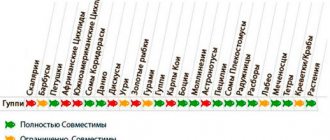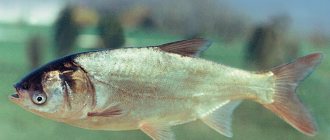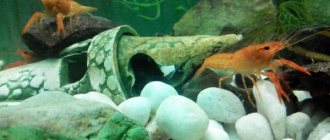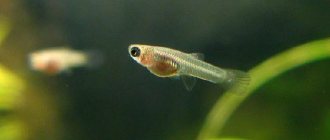Guppy fry go through the egg stage in the abdomen of the female. Guppies (Poecilia reticulata) are viviparous fish. Due to their size of 2–4 mm, newborn fry are at risk of being eaten by adults. Therefore, it is recommended to transfer it to a depositor or a separate container.
Guppies, like all fish of the order Cyprinodontiformes, do not possess maternal instinct. The female who has given birth is transferred to a general aquarium.
A 3–5 liter jar is suitable as an age aquarium if 15–20 fry were born. If more - a capacity of 10 liters.
Preparing conditions for a pregnant female
Pregnancy lasts 25–35 days.
Manifests itself in an increase in the size of the abdomen. 2–3 days before birth, the abdomen “squares up” and a dark spot appears behind.
At the final stage of pregnancy, the water is not changed. The temperature is maintained constant.
The optimal water temperature in the aquarium is 24–26 °C.
24–30 hours before giving birth, the female becomes little active, does not eat, and stays near water heating devices.
If separate keeping of juveniles is planned, then the fertilized female is placed in a prepared container with clean, transparent water and plants.
Birth of fry
After one fertilization, the female is able to give birth throughout the year in the absence of a male.
Labor lasts 1–24 hours. Completion is difficult to determine. Leave the female with the fry for 24 hours. If plants are present, the loss of juveniles is minimal.
Quantity
How many fry a guppy gives birth to depends on the age and size of the female, the number of births and the variety.
It is difficult to calculate in a general aquarium. Usually 15–60 individuals. The female can eat a certain amount during childbirth.
What they look like
Baby guppies are born fully formed. Able to feed themselves. Hiding from adult fish.
2–4 mm in length. Colorless to transparent. With big black eyes.
How they grow
The growth rate is affected by the volume of the aquarium and the quality of the water.
During the first week of life, the fry gains 5–7 mm in length. By the end of the second - up to 20 mm. Full size (40–60 mm females, 20–40 mm males) and sexual maturity are reached at 4–5 months.
When to plant in a community aquarium?
You need to focus not on the age of the fry, but on their size. Remember that for adult fish they are a real delicacy, so you can transplant young fish into a general aquarium of such a size that they probably will not fit into the mouths of adults. But it’s better to play it safe and wait until the fry grow to 1.5-2 cm. It is important to transplant young fish correctly.
You can’t just catch them with a net and release them into a community aquarium. It is necessary to add water from the general water into the aquarium in small portions during the day so that the fry adapt. A sharp change in water parameters can lead to the death of young animals. In the first week, the water temperature in the general aquarium should be close to that in the fish tank.
WHAT AND HOW MANY TIMES A DAY SHOULD YOU FEED A SCALARIA IN THE AQUARIUM
BREEDING ANKALARIUS IN A COMMON AQUARIUM
COMPATIBILITY OF COCKERS WITH OTHER FISH IN THE AQUARIUM
DISEASES OF MACROPODS: CAUSES AND TREATMENT
Types of food
Guppy fry need live and plant food. Store-bought dry ones contain everything you need, including vitamins.
Commercial feed
Ichthyologists and ichthyopathologists recommend Tetra, Sera, JBL powders.
For fry up to 1 cm long:
- Tetra MicroMin.
- Sera micropan.
- Sera micron.
- JBL NovoTom.
Tetra BioMin paste.
Natural feed
Guppies are omnivores, but the fry need protein for active growth. Protein is abundant in live food. The food is mobile, which awakens the hunting instinct in the fish. Does not spoil water.
In the first days, use home-grown food.
- "Living dust" - ciliate slipper. Size - 0.15–0.25 mm.
- Nauplia is the larva of Artemia. 0.4–0.6 mm in length. It is not used for continuous feeding due to the risk of obesity in the fry.
- Microworm - round worm, nematode. Dimensions: 0.05–1.5 x 0.05 mm. High-calorie replacement for nauplii.
- Phytoplankton are microscopic algae that are harmful to the aquarium through water blooms and are important for the diet of fry. Place the jar of aquarium water in sunlight. In a couple of days algae will appear. Use a medical syringe to place it in the aquarium.
Live food from natural bodies of water is dangerous. There is a possibility of fish poisoning, parasites and infection. Ozone disinfection will help, but it will not get rid of toxins.
Daphnia, also known as "water flea". Size from 0.15 mm depending on age and type. High protein content. There are vitamins and microelements. Lives in natural reservoirs.
Mosquito larvae and worms are fed to the fry, crushed.
Bloodworm, also known as “raspberry” because of its deep red color. Size 5–20 mm. Nutritious, but chopped spoils the water. When purchasing, pay attention to the color. Pale - young, with a minimum of nutrients. With a brown tint - old, hard, cannot be stored for long. Do not let the fish get any dead bloodworms - they will be poisoned.
Koretra is a transparent mosquito larva. 6–10 mm in length. A predator, it does not obtain food at the bottom. Therefore, in terms of infection and poisoning, it is not as dangerous as bloodworms. Low protein, not suitable for constant feeding.
The tubifex is a thread-like worm of pink color with a brown tint. Length - up to 40 mm. In nature, it lives at the bottom of silted, dirty reservoirs. High in calories, not recommended for long-term nutrition due to fish obesity.
- Useful for the growth of fry and weakened adults.
- It is enriched with vitamins if placed in a prepared solution: 250 mg of multivitamins per 100 g of tubifex.
- The most dangerous are infections and parasites, intoxication. Before feeding, a period of at least 5 days is required to remove food residues.
Plant food
Vegetable feeding is an indispensable thing for activating the growth of guppy fry. Let's consider representatives of plant-based complementary foods.
Seaweed
A representative of this food is any algae where living microorganisms actively develop. Among the large aquarium algae, smaller ones always germinate, which are the best product for the smallest aquatic inhabitants. The size of this vegetation is less than 1 mm, so it is easily digestible by baby guppies.
Zooplankton
Many aquarists often grow beneficial zooplankton at home. To do this, you need to pour the liquid into a glass and place it in direct sunlight. After a few days, green water will appear in the container, which is gradually added to the aquarium.
Growing
Adult fish hunt and eat the fry. Loss of 2/3 of the litter is likely.
In a common aquarium
If the tag is supposed to be in a common container, prepare plants that float on the surface and float in the water column. The thickets will serve as a refuge for the fry.
Raise the water temperature to 26 ° C (gradually increase over a couple of months).
Feed with finely ground “adult” food. Feeding: curdled milk, milk powder, plant foods.
For the first couple of months, change 1/3-1/4 of the water 2-3 times a week.
Aeration and filtering of water are required.
- Advantages: they grow quickly, do not get sick, strong individuals survive.
- Disadvantages: high mortality rate, the breed will not survive.
In the prison
A 2–5 liter fish tank (nursery, spawning tank) for a general aquarium can be purchased or made independently from a plastic bottle. It is not recommended to use a net with fabric walls: an adult fish will bite the fry through the fabric.
Place the spawning tank next to the heater and sprayer. Place the plants.
Place the female in a nursery 2-3 days before giving birth. Since the change in conditions is minimal, the transplant will not cause stress in the female, and the offspring will not suffer.
Once marking is complete, transfer the female to the aquarium.
And also raise the water temperature gradually to 26°C.
In the first days (3–6), feed “live dust”, ground food and dry fry food. Add dairy and vegetable fertilizers, egg yolk. During the first week, feed food around the clock at intervals of 4–6 hours in measured portions. Remove feces and leftover food.
After a couple of weeks, primary sexual characteristics will appear. Separate the males. Early pregnancy is dangerous for the female.
Transfer females to a community aquarium upon reaching sexual maturity. At the age of 4–5 months. Males - in a month.
Care, nutrition and maintenance in the first days
At the beginning of their lives, newly born guppies are removed from the general aquarium to another container, where adults cannot harm the fry. Newborns require 5-6 meals a day, but care must be taken to ensure that all food is eaten at one time to avoid settling of food residues. This significantly increases the nitrogen content, which is dangerous for guppies and can lead to their death. As for the volume of food, fry eat much less compared to adults. And dry food must be thoroughly rubbed between your fingers until it becomes a powder.
For the first couple of weeks, the light should be on constantly . It is during this period of time that the fry grow rapidly. Only after 3 months can already grown fish be moved to their relatives without fear for their safety. At first, guppies receive an amount of food that exceeds their weight by 60%. After 2-3 weeks, their diet begins to balance, and the rest of the time they consume only 15-20% of their body weight.
Only after birth are the fish fed “live dust” or microscopic organisms. These can be ciliates, rotifers, microscopic worms and others.
More than 2 weeks
Place males in a community aquarium: the fish are capable of reproduction.
Add additional food (yolk, cottage cheese, milk, vegetables, herbs) and crushed dry food to the diet of daphnia. Feed 3-4 times a day.
View this post on Instagram
Baby #guppies eating cucumber?? . #fish #aquarium #aquarium science #aqua #aquarium fish #guppy fry #fry #babies #feeding #my aquarium #fish breeding #pets
A post shared by Alice and company (@boba_co) on Sep 7, 2021 at 7:16am PDT
More than a month - add chopped bloodworms, coretra, and tubifex to the diet. Lighting 8–10 hours. Water temperature - 27 °C. Changing water and cleaning the bottom - 2-3 times a week.
Why don't the fry grow?
- If the fish are purchased, the change in conditions affects them. Difficulties with couple compatibility.
- Overcrowding of the aquarium. Choose a volume based on 0.4–0.5 liters of water per fry.
- Water quality. Lack of ventilation, filtration, irregular water changes and waste disposal are fraught with nitrate poisoning.
- Not a varied diet, not enough live food, not enough protein, overfeeding.
- Stress in a female on the eve of childbirth. Premature birth.
Guppies are unpretentious, but not juveniles. Proper nutrition of the fry in the first days after birth is important. Varied, frequent, dosed. Clean, fresh water. Temperature regime. Without proper maintenance, the fry will not reach normal size. The color of the body and fins is spoiled.
Previous
Fishes24 predatory fish for the aquarium
Next
FishFeatures of keeping a glowing aquarium fish neon
How to determine gender
Sex differences can already be seen 15 days after throwing the fry. How to determine the sex of offspring? The first signs can be seen on the abdomen of females, this is a black spot. But this cannot always be seen if, for example, silver guppies are bred. By the age of three months, males grow beautiful colorful tails and also have a sharp anal fin. In the male, almost the entire body is also colored. The female is noticeably larger than the male and faded in color. She may have colored hind and upper fins, but they are normal in size and round in shape.
When starting to raise guppies, you should not be afraid of the appearance of young animals. This is a fairly tenacious omnivorous fish that can survive the mistakes of a novice aquarist. With good care, the female gives birth to more than 100 young individuals. And a novice aquarist, after a short time, will have a large colorful flock of unpretentious but beautiful guppies in his home aquarium.










